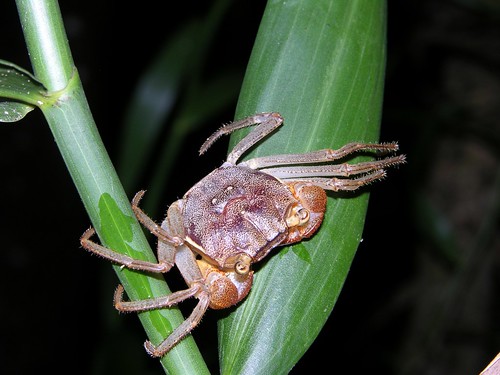The number of bird species listed as Critically Endangered has soared to an all-time high, reports BirdLife International with the release of this year’s Red List for Birds. Even so, some conservation efforts are succeeding.
“Almost 200 species of bird are now in real danger of being lost forever,” said Dr. Leon Bennun, BirdLife’s director of science, policy and information. “They are being hit on multiple fronts. Habitat loss, agricultural changes, invasive species and climate change are the principle threats. Without these problems being addressed the list will continue to grow.”
The White-winged flufftail, Sarothrura ayresi, a small, elusive, dove-sized rail endemic to Africa, is the latest to join the lengthening list of species on the brink of extinction. This secretive bird clings to survival in the upland marshes of central South Africa and Ethiopia.
Dr. Martin Fowlie of BirdLife International says, “Destruction and degradation of its high altitude wet grassland habitat, including wetland drainage, conversion for agriculture, water abstraction, overgrazing by livestock and cutting of marsh vegetation, have driven it to this precarious state.”
“Urgent action is now needed in both Ethiopia and South Africa to better understand the species’ ecology and to address these threats and save it from extinction,” blogged Dr. Fowlie in late November.
Some South African sites have some legal protection, and at least four sites are protected by the landowners. At the largest Ethiopian breeding population, the vegetation is not cut for fodder until October-November, giving the White-winged flufftails time to breed without disturbance, BirdLife reports.
The Yellow-breasted bunting, Emberiza aureola, is disappearing due to uncontrolled trapping in its wintering grounds in southern China and Southeast Asia. This once common species, classified as of Least Concern as recently as 2000, is now considered Endangered, just one step below a Critically Endangered listing.
Yet the latest bird assessments are not all discouraging. There are signs that conservation action is working.
Two species of albatross, one of the most threatened bird families, are now considered to be at a lower risk of extinction after increases in their populations.
On the Indian Ocean island of Rodrigues, two species – the Rodrigues Fody, Foudia flavicans, and the Rodrigues Warbler, Acrocephalus rodericanus– have been downlisted as a result of conservation action.
Habitat protection and reforestation, employed to protect the island’s watershed, as well as the absence of catastrophic storms, have helped these species to recover.
The government of Egypt, in cooperation with Germany, Switzerland and other partners, has pledged to assess and further address the issue of unregulated hunting and bird netting practices along the Mediterranean coast of Egypt.
The hunting and trapping of migratory birds in Egypt and Libya, through the use of mist nets along vast stretches of the Mediterranean coast, have become issues of growing public concern. Regulatory frameworks are in place, the challenge lies in their enforcement.
“Bird trapping in these countries is an ancient tradition. The main target species, Common Quail, is a local delicacy,” said Marcus Kohler, BirdLife’s senior program manager for Flyways.
“It’s a legitimate way for local people to supplement their diet,” said Kohler. “However, the indiscriminate nature and scale of the trapping has now reached worrying proportions and is having an impact upon other species.”
Current estimates are that millions of birds are caught each autumn as they leave Europe and Asia for their wintering grounds in sub-Saharan Africa.












 「我覺得有點像豐年祭,但又比豐年祭能有參與感。」樂迷ET表示,ET在一年前環島時認識並愛上都蘭的美景,更逐漸開始接觸原住民文化,在一些關懷社會的獨立音樂人的推廣下,也關心起東海岸面臨的開發危機。但對她而言,年祭其實是部落自己的活動與儀式,「我覺得我像一個旁觀的陌生人,很喜歡他們但是也沒辦法在那時好好認識他們。」ET回憶之前的經驗。
「我覺得有點像豐年祭,但又比豐年祭能有參與感。」樂迷ET表示,ET在一年前環島時認識並愛上都蘭的美景,更逐漸開始接觸原住民文化,在一些關懷社會的獨立音樂人的推廣下,也關心起東海岸面臨的開發危機。但對她而言,年祭其實是部落自己的活動與儀式,「我覺得我像一個旁觀的陌生人,很喜歡他們但是也沒辦法在那時好好認識他們。」ET回憶之前的經驗。



 Suming則認為,阿米斯音樂節難以直接複製到其他部落,因為這是部落自己要的,並非提供補助給每個部落就能成行,且也不見得每個部落都適合音樂節。Suming強調,雖然這個夢想的起頭,是他自己很希望能在故鄉辦演唱會,但也是他多年來投入訓練未成年青少年「巴卡路耐」後的成果,不但漸漸取得了部落的認同與信任,也培養了願意支持與合作的伙伴。
Suming則認為,阿米斯音樂節難以直接複製到其他部落,因為這是部落自己要的,並非提供補助給每個部落就能成行,且也不見得每個部落都適合音樂節。Suming強調,雖然這個夢想的起頭,是他自己很希望能在故鄉辦演唱會,但也是他多年來投入訓練未成年青少年「巴卡路耐」後的成果,不但漸漸取得了部落的認同與信任,也培養了願意支持與合作的伙伴。 「如果部落的人聚起來,其實資源並不需要擔心,重要的是在籌備的過程中,討論出共識,知道自己要什麼。」此次擔任志工的大學生拉外來自台東matang部落,便從阿米斯的音樂節感受到可能性,拉外認為,比起官方辦的活動時常強加部落某些刻板的形象,由部落自主來辦,才有決定要表現出怎樣的自己,主導詮釋部落的權力。「不用盛大,也不需要華麗,而是要真實、真誠,而且重點是過程,與之後的延續性,才是對部落有意義的。」
「如果部落的人聚起來,其實資源並不需要擔心,重要的是在籌備的過程中,討論出共識,知道自己要什麼。」此次擔任志工的大學生拉外來自台東matang部落,便從阿米斯的音樂節感受到可能性,拉外認為,比起官方辦的活動時常強加部落某些刻板的形象,由部落自主來辦,才有決定要表現出怎樣的自己,主導詮釋部落的權力。「不用盛大,也不需要華麗,而是要真實、真誠,而且重點是過程,與之後的延續性,才是對部落有意義的。」 Suming指出,其實目前許多部落當中,也有不少青年如同幾年前的他,正在努力想為部落作點事情,例如此次參與演出的嵐馨樂團,便是以鄰近的都歷部落青年阿里要為首,也陪伴著他們的巴卡路耐,教他們創作,也一起上台演出。「第一步的確是最難克服的。」Suming不但盡量分享機會,更以「要相信自己是對的。」來鼓勵目前仍處於不受支持困境、感到受傷的族人。
Suming指出,其實目前許多部落當中,也有不少青年如同幾年前的他,正在努力想為部落作點事情,例如此次參與演出的嵐馨樂團,便是以鄰近的都歷部落青年阿里要為首,也陪伴著他們的巴卡路耐,教他們創作,也一起上台演出。「第一步的確是最難克服的。」Suming不但盡量分享機會,更以「要相信自己是對的。」來鼓勵目前仍處於不受支持困境、感到受傷的族人。













 自救會表示,此工程不但穿過海堤,更將管線埋在新復溝河道之下,在不信任英華威的施工品質下,他們擔心在該地區大潮時原本就會淹水的情況下,可能會發生漏電等危機,而海堤若應工程變得脆弱,也將造成危險。
自救會表示,此工程不但穿過海堤,更將管線埋在新復溝河道之下,在不信任英華威的施工品質下,他們擔心在該地區大潮時原本就會淹水的情況下,可能會發生漏電等危機,而海堤若應工程變得脆弱,也將造成危險。 而水利署派出副總工程師劉昌文接受陳情,表示尊重陳情意見,將依法保障民眾生命財產安全,也會要求第二河川局督促英華威公司加強與當地民眾溝通協調。
而水利署派出副總工程師劉昌文接受陳情,表示尊重陳情意見,將依法保障民眾生命財產安全,也會要求第二河川局督促英華威公司加強與當地民眾溝通協調。









 人們常常不自覺自己對大自然的掠奪,以為伐木、打獵才是破壞生態,而把花果帶回家是一種「愛自然」的表現。其實過度的拿取也是一種對自然的傷害。植物的開花結果不是為了向人們展現它的美麗與可愛,而是為了傳宗接代,提供森林裡的動物需要的食物,也進入土壤中發芽成為小苗,再茁壯成為大樹。若是人們把樹上、把地上的果實搜括一空,不留一點給動植物,便會漸漸造成生態的失衡。
人們常常不自覺自己對大自然的掠奪,以為伐木、打獵才是破壞生態,而把花果帶回家是一種「愛自然」的表現。其實過度的拿取也是一種對自然的傷害。植物的開花結果不是為了向人們展現它的美麗與可愛,而是為了傳宗接代,提供森林裡的動物需要的食物,也進入土壤中發芽成為小苗,再茁壯成為大樹。若是人們把樹上、把地上的果實搜括一空,不留一點給動植物,便會漸漸造成生態的失衡。




